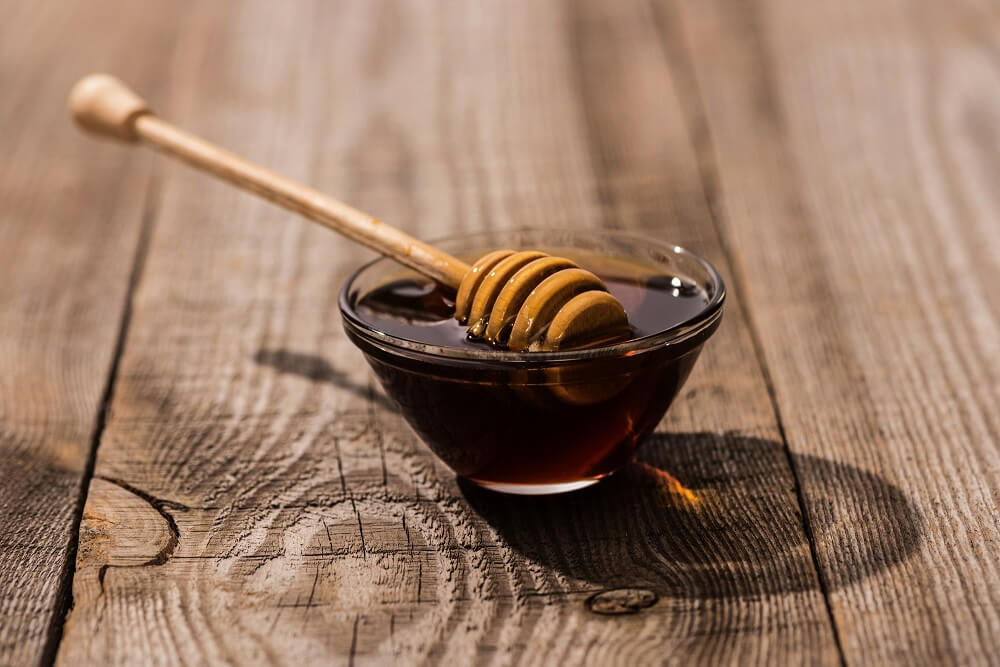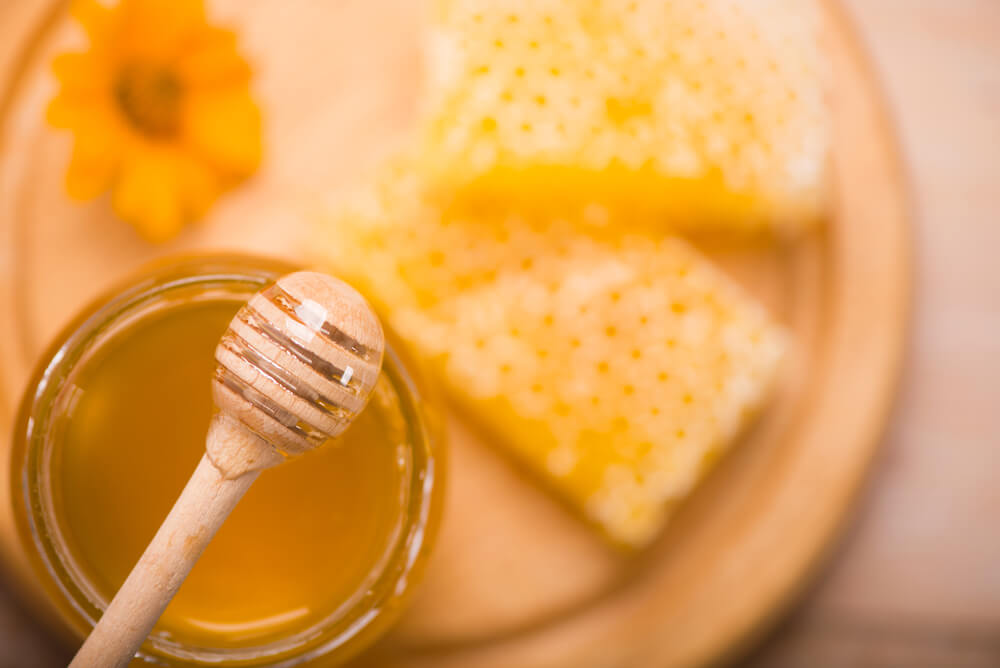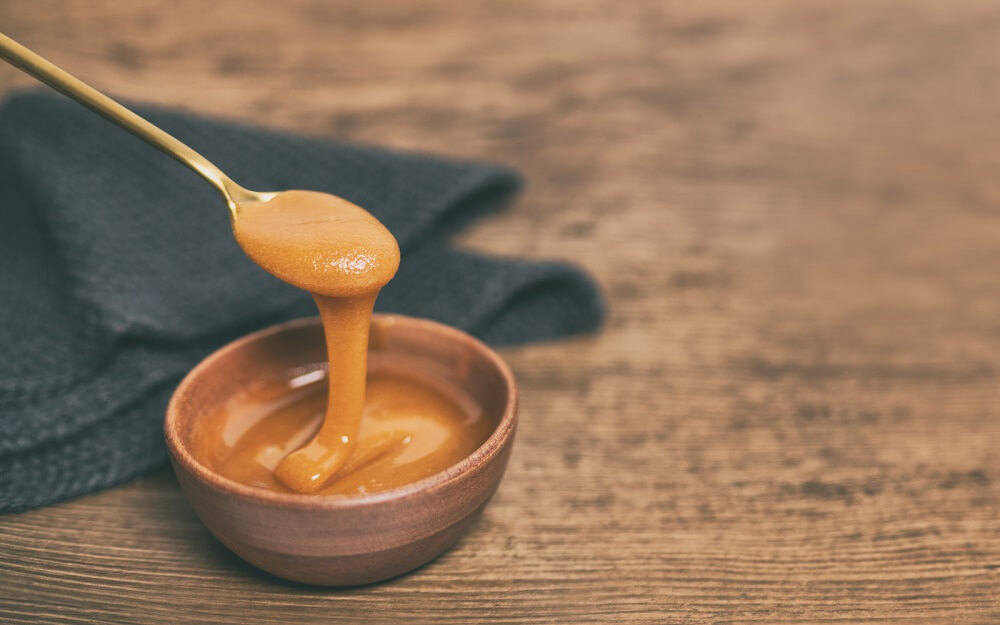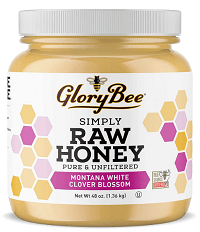Table of Contents:
How to Make Fermented Honey
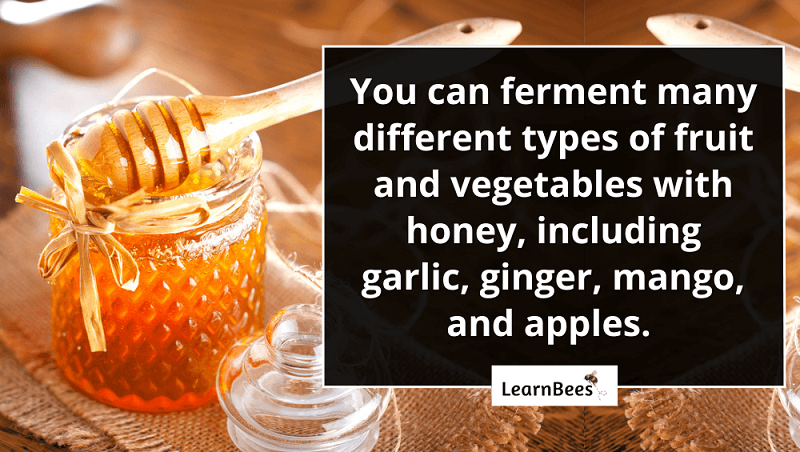
Fermentation is a process that breaks down carbs by yeast and bacteria. It creates a unique tart flavor for foods like cheese, yogurt, and sauerkraut.
When you ferment honey, both the honey and produce get even tastier.
You can ferment honey with several different foods, including:
- Garlic
- Jalapenos
- Figs
- Ginger
- Onions
- Herbs
- Cranberries
Fermented Honey Recipe
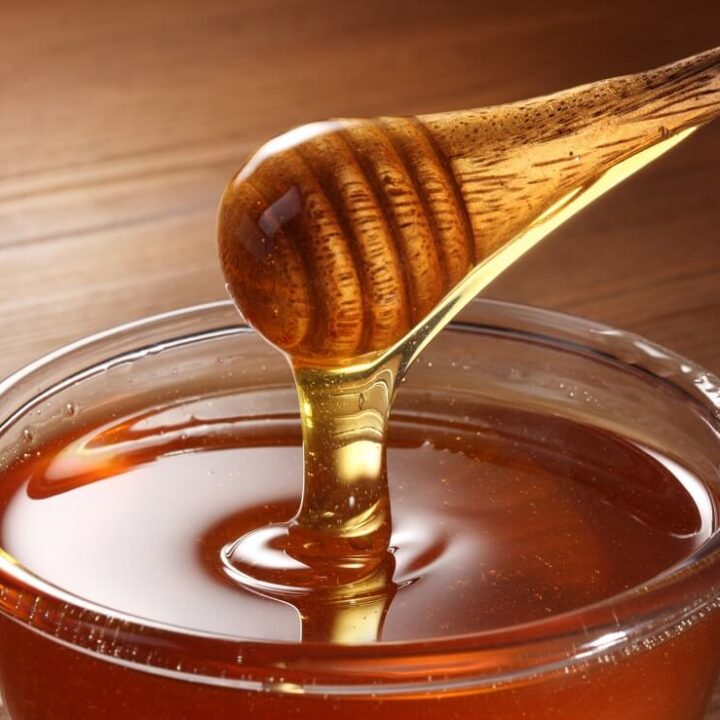
Fermented garlic honey is one of the most popular recipes, but you can try different fruits and vegetables with this recipe.
Ingredients
- 1 cup peeled garlic cloves
- 1 cup raw honey
Instructions
Step 1: Peel & crush the garlic
- Begin by peeling the garlic cloves. Next, lightly crush the cloves, which will help speed up the fermentation process.
- Place the crushed garlic in a sterilized glass jar with an airtight seal.
Step 2: Drizzle the honey over the garlic and allow fermentation to begin
- Top the jar with honey, gently stir to mix it and close it with an airtight lid.
- Once sealed, turn the honey jar upside down (this is why a tight seal is crucial) and set it aside. Put a plate beneath the jar, just in case there is leakage.
- You should ‘burp’ the jar daily for 14 days. Burping involves unscrewing the lid to allow any co2 gases to release. Then close the jar and shake it, flip it upside down again, and place it aside.
- Move fast while burping the honey because you don't want to introduce too much oxygen into the jar, which can affect fermentation. Just a quick opening of the lid is sufficient to release the co2 gases.
- If for some reason fermentation hasn't started after a few days, you can add in a few spoonfuls of water to thin out the honey.
- After 14 days, the fermented honey is yours to eat. You can wait a month or longer for even better results.
What is Fermented Honey Used For?
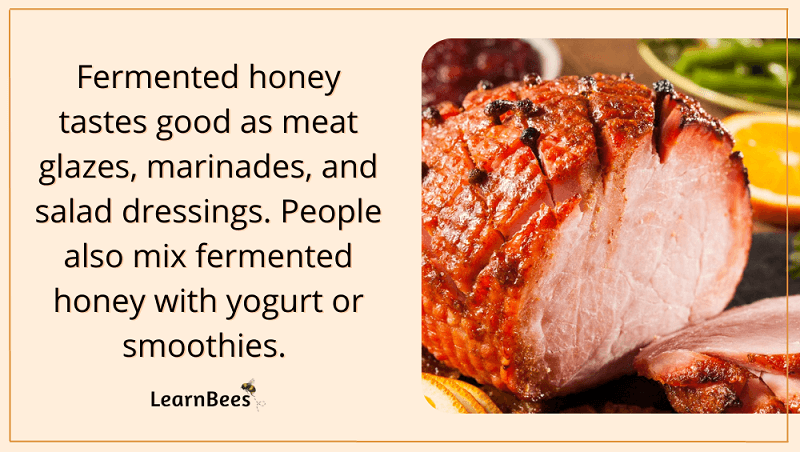
People often use fermented honey for salad dressings, glazes, and marinades. Fermented honey also pairs well with yogurt parfaits, smoothies, and lemonade.
For example, a garlic honey marinade is delicious to flavor fish, chicken, and vegetables. You simply toss the food in the honey garlic marinade and let it sit for six to 24 hours.
But that’s not all.
Fermented honey also comes with its fair share of health benefits.
For example, honey is rich in antioxidants that help our bodies fight inflammation, such as redness and swelling. Honey can help balance our immune system and reduce the chances of obtaining certain illnesses.(1, 2)
Additionally, one study found that garlic juice and honey stopped certain types of bacterial infections that can’t be treated by antibiotics.(3)
So, in a nutshell:
People use fermented honey because they enjoy both the taste and health benefits.
How Long Does it Take for Honey to Ferment?
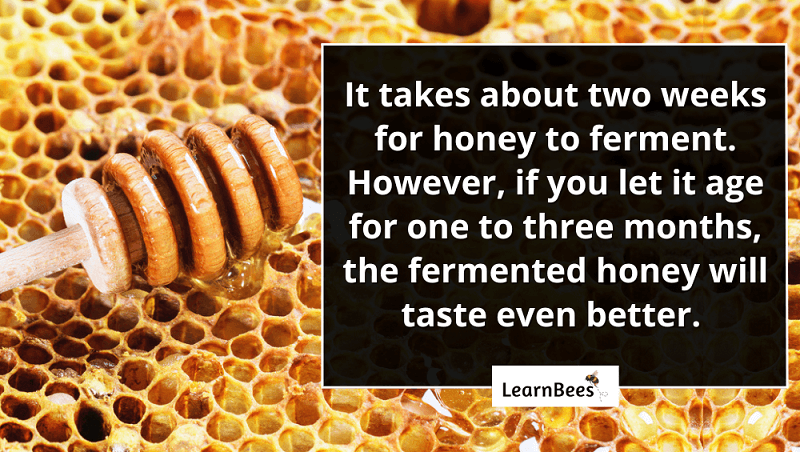
It takes at least two weeks for honey to ferment. Afterward, you can enjoy the fermented honey for glazes, marinades, or salad dressings.
If you want a stronger flavor, wait a month or longer for the fermentation process to complete. Fermented honey tastes the best when given at least three months to age.
During fermentation, the honey will become runnier and develop a stronger flavor. The final product should have a light brown color and a mildly acidic taste.
If you want to speed up the process, add a few spoonfuls of water to thin out the honey. But in most cases, the honey will extract enough moisture from the produce you’re fermenting.
FAQs on Fermenting in Honey
- What does fermented honey make?
- Why is my honey bubbling?
- Is fermented honey OK to eat?
- Is fermented honey good?
- Why has my honey fermented?
- How do you keep raw honey from fermenting?
- Why does my honey smell fermented?
- How do I know if my honey is fermenting?
- What is fermented honey called?
- Can bacteria grow in honey?
- How long does honey take to ferment?
- How long is fermented honey good for?
- What is the taste of fermented honey?
- Can crystallized honey ferment?
- Can you get botulism from fermented honey?
- Does honey slowly ferment?
- Can honey ferment in the comb?
- What are the benefits of fermented honey?
What does fermented honey make?
Fermented honey makes a great glaze for chicken or fish. You can also use it to make salad dressings, marinades, or toppings for yogurt parfaits. You can also make mead out of fermented honey, which is a type of alcoholic beverage.
Many people ferment honey because they love the taste and endless possibilities. You can ferment many different kinds of vegetables and fruits, including ginger, turmeric, garlic, apples, apricots, and mangos.
—> Go back to the FAQs on fermenting in honey
More to Explore:
Why is my honey bubbling?
Honey could be bubbling due to fermentation. However, sometimes honey bubbles naturally with no signs of fermentation. Fermentation typically smells like vinegar, so if your honey smells fine, it’s probably just the natural process some honey undergoes. Just make sure your honey is stored in an airtight container.
—> Go back to the FAQs on fermenting in honey
More to Explore:
- Honey Pasteurization: Does it Ruin Raw Honey?
- Honey for Skin Benefits: Directions, Uses, & Risks
- 8 Scientific Benefits of Raw Honey
Is fermented honey OK to eat?
Yes, fermented honey is safe to eat. In fact, it’s rich in antioxidants which have health benefits such as reducing inflammation.
However, you may not like the taste of fermented honey unless you do it on purpose. This is why you should keep your raw honey sealed in an airtight jar so it doesn’t ferment due to excess moisture getting in the jar.
If you want to ferment honey on purpose, you can try fermented garlic honey, fermented onion honey, and many other types of fermented honey.
—> Go back to the FAQs on fermenting in honey
More to Explore:
Is fermented honey good?
Many people enjoy the taste of fermented honey. Fermented honey has a strong flavor and can be used in many different dishes. You can mix it into smoothies, juices, yogurt, or other dishes that complement it.
What’s more, honey itself has numerous health benefits. For example, it’s rich in antioxidants and can help boost your immune system. Many people also use honey to help soothe sore throats.
You can ferment certain vegetables and fruit to make the honey even healthier. For example, fermenting ginger, turmeric, or garlic can increase the health benefits of honey.
—> Go back to the FAQs on fermenting in honey
More to Explore:
Why has my honey fermented?
If you’ve noticed that your honey has started to ferment, it’s likely because it wasn’t stored properly. Honey should be stored in a cool, dark place. If it’s stored in a warm place, the fermentation process will start, and the honey will start smelling acidic.
—> Go back to the FAQs on fermenting in honey
More to Explore:
How do you keep raw honey from fermenting?
To keep raw honey from fermenting, store it in a cool, dark place with an airtight lid. The airtight is important because it will keep moisture from getting to the honey and starting the fermentation process.
—> Go back to the FAQs on fermenting in honey
More to Explore:
Why does my honey smell fermented?
If your honey smells like vinegar, it’s probably because it has started to ferment. This can happen if the honey isn’t sealed correctly and moisture creeps into the container.
—> Go back to the FAQs on fermenting in honey
More to Explore:
How do I know if my honey is fermenting?
If your honey has started to ferment, you’ll notice that it’s runnier and frothy. It will also have a mildly acidic taste and smell.
—> Go back to the FAQs on fermenting in honey
More to Explore:
- The Top 3 Best Manuka Honey Brands
- Orange Blossom Honey: Uses, Benefits, & Risks
- Sourwood Honey: Uses, Benefits, & Risks
What is fermented honey called?
Fermented honey is simply called fermented honey. Mead is another type of fermented honey that turns into alcohol.
—> Go back to the FAQs on fermenting in honey
More to Explore:
- Beeswax vs. Soy Wax: Which is Better for Candle Making?
- How to Make Beeswax Lip Balm
- Does Honey Need to Be Refrigerated?
Can bacteria grow in honey?
Yes, bacteria can grow in honey if you don’t store it in an airtight jar and use only clean utensils when dipping into it. However, the high sugar content in honey creates an environment that is not conducive to growing bacteria. So as long as you store the honey correctly, you don’t have to worry about bacteria growing in it.
—> Go back to the FAQs on fermenting in honey
More to Explore:
How long does honey take to ferment?
It usually takes at least two weeks for honey to ferment. With that said, the longer you allow the honey to age, the better. Many prefer waiting at least three months to get the full flavor profile.
—> Go back to the FAQs on fermenting in honey
How long is fermented honey good for?
Fermented honey can last very long as long as it’s stored in a cool, dark place. We recommend keeping the fermented honey for no more than 12 months.
—> Go back to the FAQs on fermenting in honey
What is the taste of fermented honey?
Fermented honey has a strong, distinct flavor. It’s often described as tangy, slightly acidic, and sweet. Fermented honey will also take on the flavor of whatever produce you put in it. For example, fermented garlic honey will taste like garlic with a honey undertone.
You can ferment many things in honey, including:
- Onions
- Hot peppers
- Mango
- Cranberries
- Ginger
- Tumeric root
—> Go back to the FAQs on fermenting in honey
Can crystallized honey ferment?
Yes, crystallized honey can ferment.
—> Go back to the FAQs on fermenting in honey
Can you get botulism from fermented honey?
Yes, it’s rare, but it can happen. However, botulism can’t survive in an environment with a pH lower than 4.6. Simply test your honey mixture with pH strips or a meter, then add a small amount of apple cider vinegar if necessary to lower the pH.
For example, with any type of garlic infusion, there is some potential risk of botulism. Garlic bulbs can pick up the bacteria from the soil that cause botulism. Fermenting garlic in honey can encourage the growth of the toxins responsible for food-borne botulism.
—> Go back to the FAQs on fermenting in honey
Does honey slowly ferment?
Honey is less likely to ferment if you store it in an airtight container. That said, if you’re purposely trying to ferment honey, you can expect to wait at least two weeks for the process to complete.
You can speed it up by adding a bit of water to the fermented honey. Water helps to kickstart the fermentation process.
—> Go back to the FAQs on fermenting in honey
Can honey ferment in the comb?
Honey can ferment in the comb.
Once the honey begins to ferment, the cells will have bubbles and a yeasty smell. The fermenting smell can be either subtle or very strong. Occasionally, you may notice foam oozing out of the comb and collecting under the frames.
As a rule of thumb, beekeepers who harvest and bottle honey like to keep the uncapped cells to a minimum – usually no more than 10% of the total. Some beekeepers choose to do more which might require dehydrating the honey to reduce the chances of fermenting.
—> Go back to the FAQs on fermenting in honey
What are the benefits of fermented honey?
Fermented honey has several benefits.
First, it’s a great probiotic food. Probiotics are beneficial bacteria that help to keep your gut healthy. They improve digestion and help to keep harmful bacteria in check.
Fermented honey also contains antioxidants and enzymes that are beneficial for your health. Additionally, fermented honey may have more health benefits depending on what you add to it. For example, garlic has its share of benefits.
So when you ferment garlic and honey, you get a nice concoction of benefits.

